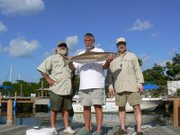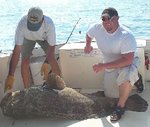Hey! Take a kid fishing!

Doing the fishing 101 guide trips is a lot of fun for me. Yesterday I had a crew from Indiana. Three generations, Grandpa, the sons and the grandkids. The grandkids were 4 to almost 5 years old. Nobody was really sure how the kids would take to fishing so we stayed pretty close to the house just in case.
We started with a little bayside mackerel fishing. When I am doing the guide trips I don’t give out any of my honey holes, I show the crew how to find their own. So we shot back in the bay and I describe to the crew what to look for when hunting for a productive spot. While we are running I told the crew about how the water color changes with the type of bottom and which type of bottom you look for depending on the fish you want.
We hit a nice a nice grass area about 7 miles from the dock and I stop the boat, a 26 foot Triton they rented. I explain once again what I’m looking for in a mackerel area, (vacationers are always excited the first time out so you need to repeat a few times). We put the chum bag over and they put a few lines out with dead shrimp on for bait. After mentioning that they didn’t need any weight, just a short wire leader, the crew takes off their heavy sinkers.
After waiting for what seemed an eternity, (6 minutes) we finally had a fish on. I watched the fish, a decent Spanish mackerel run around for a few seconds before I announced “fish on.” Dad helped Colin, reel in the first fish of their Keys fishing vacation on the rental boat.
I took all of an hour to catch all the mackerel they wanted then we headed in for an early lunch and potty break. After reloading the bait tank with live shrimp and a few pinfish we hit the Seven Mile Bridge. The keeper snapper fishing was a bit slow, but there was plenty of just short mutton snapper, black and red grouper and jacks to stretch the lines.
The crew was kind of surprised when I said it was about time to head back to the dock but the kids where ready for a break. For me it was a slow trip. About a dozen keepers and maybe forty releases. One big mystery fish, probably a shark, was the only hoss of the trip. The crew was more than happy with the results and with the intro to Keys fishing are sure to do well on their own for the few days.
So if you are coming to the Keys, bring the kids and hire a guide for the first day out. Don’t wait for the last day like so many vacationers tend to do. There are plenty of places where kids of all ages can have fun catching.
Until next time,
Tight lines.
Capt. Dallas






